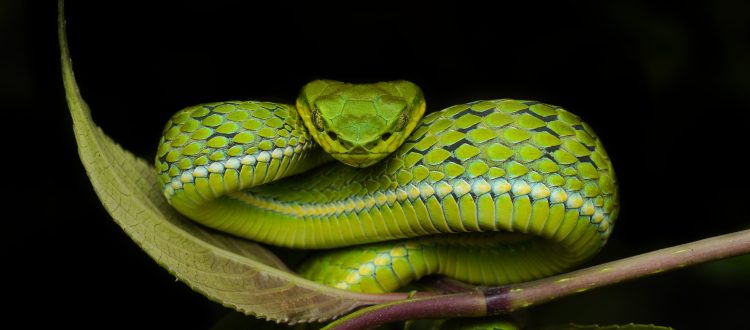Munnar – A reptile hotspot!
My passion for reptiles has been a lifelong fascination, and it significantly shaped my career path in wildlife. The pivotal experience of curating the Parassinikadavu Snake Park back in 2021 further deepened my appreciation for these captivating creatures. After taking up my current role of a field biologist for Wildlife Trust of India’s Amphibian Recovery Project in Munnar, I was stunned by the remarkable diversity of reptiles in this area. Recognised as a hotspot for many species, Munnar hosts a rich diversity of snakes, lizards, turtles, and more.

Striped coral snake (Calliophis nigrescens) in Munnar | Photograph by Abhijith Vijay/WTI
Shield tailed snakes – the buried treasures!
Endemic to the Western Ghats and Sri Lanka, Shield-tailed snakes constitute a group of primitive, non-venomous burrowing serpents. They primarily inhabit subterranean environments and rarely emerge, particularly after a significant amount of rainfall saturates the air columns inside the soil. This behaviour makes spotting these snakes a challenging endeavour. Before this, I had encountered a live Shield-Tailed snake only once. However, Munnar introduced me to the astonishing richness and abundance of these snakes. Remarkably, every observation of Shield-Tailed snakes I made was purely accidental, requiring no deliberate effort on my part!
The rare and the abundant
These mountains are not only famous for the Shield-Tailed snakes, but several other endemic reptiles including the Large-scaled pit viper (Craspedocephalus macrolepis), Gunther’s vine snake (Ahaetulla dispar), Anamalai wood snake (Xylophis mosaicus), Anamalai spiny lizard (Salea anamallayana) and the Large-scaled forest lizard (Calotes grandisquamis). The Anamalai wood snake is a very recent discovery (https://europepmc.org/article/med/32230180) from the Eravikulam National Park. The Large-scaled pit viper however is one of the most frequently encountered snakes in Munnar. Its habitat spans across high-altitude sholas, evergreen forests, and extends into tea and cardamom plantations. When enquiring about snakes from plantation workers, the consistent response is, “Yes, there is plenty of ‘chattithalayan’ (the local name for the Large-scaled pit viper) among the bushes. We usually close to 10 individuals within a 40 or 50-metre stretch of vegetation!”

Anamalai wood snake (Xylophis mosaicus) in Munnar | Photograph by Abhijith Vijay/WTI
Camping among snakes
In the past one year, we have been conducting systematic surveys in the Munnar landscape to understand the distribution of various frog species. During this time we also encountered several species of reptiles. But numerous sightings of snakes and lizards also occur in close proximity to WTI’s field station, along the road, or near the parking area. Dr. Harikrishnan, the head of the Amphibian Recovery Project, often encounters them during his casual tea-time strolls. Among the several finds are the Shield-tailed snakes, the strikingly beautiful Striped coral snakes (Calliophis nigrescens) and the Bibron’s coral snake (Calliophis bibroni). While both species of Coral snakes are found in many parts of the Western Ghats, the ones found in Munnar display striking coloration, attracting wildlife photographers from across the country.
The star of the hills
Another fascinating species takes residence in the hills of Munnar —the Indian star tortoise (Geochelone elegans). This is also among the most trafficked reptile in the country. These tortoises stand out as a major attraction in the Chinnar Wildlife Sanctuary. Positioned on the Eastern side of the Western Ghats, Chinnar is recognized as a rain shadow region. The sanctuary serves as a rehabilitation haven for trafficked Star tortoises, where they are released after any rescue. Despite a significant population, spotting them is not an easy task. Also sharing the landscape is the Indian chameleon (Chamaeleo zeylanicus), the Mugger crocodile (Crocodylus palustris) and numerous geckos. Chinnar may be the only place in Munnar where one can spot all the big four snake species: Spectacled cobra, Russell’s viper, Indian krait and the Saw-scaled viper.

Indian star tortoise (Geochelone elegans) in Chinar | Photograph by Akshay Moti
Despite the glory, a threat looms large
While Munnar boasts a diverse array of reptiles; they also face myriad threats. Being a prominent tourist destination in Kerala, the congested roads and high vehicular traffic account for substantial fatalities. It has been disheartening for me to observe many rare and endemic species as roadkills. Post-COVID, there has been a notable surge in tourism, which unfortunately is taking its toll on the delicate ecosystem. The rapid growth of infrastructure in the region over recent years hasn’t been helpful either. In the past decade, the effects of climate change have further compounded the challenges faced by these vulnerable creatures, potentially jeopardising their survival.
The Munnar landscape hosts a wide diversity of amphibians as well, which like their global counterparts, face similar threats and are considered one of the most threatened vertebrate groups in the world. WTI is currently engaged in the Amphibian Recovery Project in Munnar to conserve the threatened amphibians of the landscape.
Abhijith is our field biologist engaged with the Amphibian Recovery Project in Munnar









